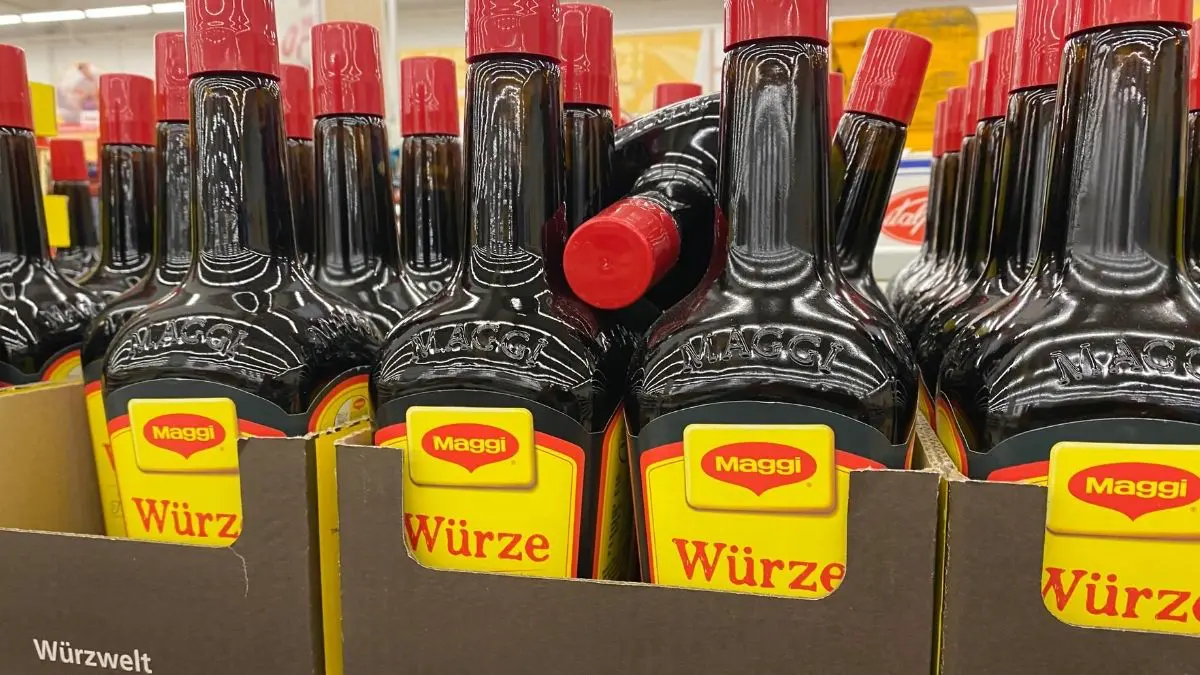Answer: Yes.

Maggi is a world-renowned brand for its various seasonings, sauces, bouillons, and instant noodles. For almost 125 years, Maggi has served households with savory ingredients that helped their special dishes reach the next level.
Today, the seasoning brand is owned by Nestle and is committed to environmental sustainability through careful management of factory operations and waste, improvisation of packaging, and responsibly sourced raw ingredients from sustainable providers.
All Maggi Liquid Seasonings are naturally vegan but may contain traces of milk and eggs due to shared processing equipment. Their seasonings either contain wheat or soy.
So whether you use Maggi Seasoning for your meals is totally up to you. While we go over the food-safe ingredients behind Maggi Seasoning in the next paragraphs, we’d also want to look into the other products of Maggi and see if you would be able to stock up your pantry with their prized seasonings, sauces, bouillons, and instant meals.
Table of Contents
Maggi Liquid Seasoning
Arome Seasoning
Arome translates to “aroma” in French, and that’s what this Maggi Seasoning is best known for. It’s best used for vinaigrettes, marinades, and vegetable stirfry since it brings a unique fragrance to hot and cold dishes.
A teaspoon serving contains 5 cal, 460 mg sodium, less than 1 g carbs, and less than 1 g protein. It’s a good practice to only use a teaspoon of this Maggi Seasoning in your meals since its sodium content already makes up for 20% of the acceptable daily intake (ADI) of an average adult consuming 2,000 cal per day.
Overconsumption of sodium may lead to increased heart rate and blood pressure.
Ingredients:
- Water
- Salt
- Monosodium Glutamate
- Hydrolyzed Wheat Protein
- Sugar
- Xylose
- Acetic Acid
- Disodium Inosinate
- Artificial Flavor
Monosodium Glutamate (MSG)
Monosodium glutamate, also known as MSG, is a common food enhancer in Asian cuisine and canned food. Although it’s considered safe in trace amounts, it remains a controversial ingredient infamous for anecdotal reactions such as nausea, chest pain, headache, and fatigue.
According to Healthline, MSG turns out to be a natural substance that can be found in many foods that we eat, such as tomatoes, and can also be produced by our body; therefore, it’s a nonessential mineral that must be taken moderately. Food additive MSG comes from the fermentation of starchy sugars such as beet sugar, cane sugar, and molasses.
MSG is a widely-used salt substitute known to produce an umami flavor in dishes. MSG may perform as a good substitute in people with high sensitivity and reactions to salt since it also causes people to desire less salt without sacrificing taste.
Despite all the controversy behind MSG, there isn’t much to worry about since the average person can’t consume MSG up to dangerous levels. According to the FDA, an average adult consumes about 13 g of glutamate each day from protein foods like soy, while intake of added MSG usually comes to around 0.55 g per day. The ADI of MSG is 14 mg per pound of body weight, that’s quite higher than what we normally consume on a regular diet.
While the MSG flavoring found in Maggi seasoning isn’t at all harmful, the sodium content and hydrolyzed wheat protein may cause reactions in those who excessively consume sodium and those who may have celiac disease.
Xylose
Xylose translates to “wood” from ancient Greek, which was so named because it’s a sugar isolate of wood. It’s commonly used as a sugar substitute for food and beverages and is ideal for diabetic individuals. Xylose may also be known as D-Xylose and can be reduced via catalytic hydrogenation to produce another common sweetener, Xylitol.
Xylose is generally considered safe as a food additive and can be absorbed by the body without any adverse or lingering effects. It can also be found in fruits, wheat, and vegetables.
Acetic Acid
Acetic acid is almost synonymous with white vinegar since it’s mainly responsible for its sour taste and pungent smell. While vinegar is made up mostly of acetic acid, the acid itself as a substance has many other uses, including the production of plastics, dyes, photographic chemicals, and rubber.
Raw acetic acid in liquid and vapor forms may immediately cause irritations on the eyes, skin, respiratory tract, and other mucous membranes, but food-grade acetic acid is specially formulated to be consumer safe. This is the type of acetic acid that you will find in most seasoning sauces and vinegar and is usually non-irritating in liquid and vapor forms.
Disodium Inosinate
Disodium inosinate (E631) is a salt of inosinic acid and is used as a food additive commonly paired with MSG to achieve a rich, umami taste in artificially flavored seasoning. It can also be found in packaged food such as potato chips and instant noodles.
Many people would argue that disodium inosinate is a non-vegetarian substance since it was originally and commonly derived from meat proteins such as pork, beef, and chicken. However, disodium inosinate manufactured from the fermentation of sugars or yeast extract is slowly becoming more mainstream as it’s easier and cheaper to produce it the vegetarian way.
According to JECFA standards, disodium inosinate is safe for consumption in trace amounts, vegan, halal, kosher, and gluten-free. See full info on disodium inosinate here.
Maggi also claims that the original recipe of their seasoning is vegetarian but can also be considered vegan except for the possible trace amounts of milk and eggs due to equipment cross-contamination.
Asian Seasoning
Experience authentic Asian flavors with a few dashes of this seasoning sauce. Perfect for stir-fried vegetables.
A teaspoon serving contains 500 mg sodium and less than 1 g carb. This 5 ml serving contains no calories, fats, or proteins. Practice moderate consumption using only 1 teaspoon per meal.
Ingredients:
- Water
- Iodized Salt (Salt, Potassium Iodate)
- Wheat Gluten
- Roasted Wheat Flour
- Less than 2% Sugar
- Caramel Color
- Acetic Acid
- Wheat Bran
- Artificial Flavor
- Disodium Guanylate
- Disodium Inosinate
- Dextrose
This product is not recommended for people with celiac disease due to the wheat gluten base.
Disodium Guanylate
Disodium guanylate (E627) is another common food additive used as a salt substitute and a flavor enhancer. Commonly paired with MSG or glutamic acid, this cocktail of glutamates makes food taste savory and desirable. In some cases, they could even be addictive, as reported that humans react more to the taste synergy of MSG and DSG than MSG alone.
Like MSG, DSG is also manufactured from sugary starches such as tapioca starch and sometimes yeast, mushrooms, and seaweed. DSG may be identified under “yeast extract” and “natural flavors ” on some food labels.”
The combination of DSG and DSI lessens the use of table salt in seasonings, sauces, soups, and other dishes, but only with the addition of MSG to the mix does the food achieve a rich, umami flavor.
Dextrose
Dextrose is a simple sugar derived from corn or wheat and is chemically identical to glucose or blood sugar. Dextrose is often used as a sweetener in baked products, processed foods, and also corn syrup. Dextrose may also be prescribed to diabetic patients with low blood sugar, but people with high blood sugar should avoid dextrose as much as possible.
They have many medical uses, especially during intravenous feeding of patients, but the average, healthy person should moderate their intake of food infused with dextrose.
European Seasoning
Jumping over to European flavors, this seasoning serves best in salads, soups, sauces, and other vegetable dishes. Use sparingly and in quick dashes.
A teaspoon serving contains 5 cal, 490 mg sodium, less than 1 g carb, and less than 1 g protein.
Ingredients:
- Water
- Salt
- Hydrolyzed Wheat Protein
- Monosodium Glutamate
- Sugar
- Acetic Acid
- Disodium Inosinate
- Artificial Flavor
The only difference with Arome Seasoning is the absence of the sweetener Xylose.
Jugo Seasoning
The Mexican-style seasoning adds a burst of flavor to soups, sauces, marinades, dressings, or snacks. It contains soy allergen and sometimes wheat gluten.
A teaspoon serving contains 5 cal, 520 mg sodium, and 1 g carb. The Maggi sauce with the highest sodium content and carbs yet the fewest ingredients.
Ingredients:
- Hydrolyzed Soy and Corn Proteins
- Maltodextrin
- Caramel Color (Selfites)
- Water
Maltodextrin is a food additive produced from vegetable starch such as rice, corn, potato, or wheat and is commonly used as a thickening agent in sauces, pastries, puddings, and salad dressings. It’s also used as a preservative for packaged foods.
Although maltodextrin is sourced from natural ingredients, it’s heavily processed and has no nutritional value. People with diabetes and celiac disease should avoid foods rich in maltodextrin.
Other Maggi Seasonings
While there are 9 formulations of Maggi Liquid Seasoning worldwide, the four products mentioned above are the most popular and accessible to US consumers. Regardless, the other 5 variants share the same ingredients with very few exceptions; hence, they are also safely vegetarian, but the disclaimer for possible cross contaminants should still alert vegans.
There are 3 types of Maggi Liquid Seasoning in the Philippines: Maggi Savor Classic, Maggi Savor Calamansi, and Maggi Savor Chilimansi (chili and calamansi). Maggi also has a powdered granule-type seasoning in the Philippines called Maggi Magic Sarap (savor).
There is also the Swiss version of Maggi Wurze and the original Maggi liquid seasoning.
Are Maggi Seasonings Healthy?
They’re great for food, but they lack any sort of nutritional value, and as we’ve reviewed the ingredients lists of the previous Maggi Seasonings, then we can immediately conclude that these sauces must be used in moderation, and a teaspoon serving would be enough in any meal.
Vegans are safe to use Maggi Seasonings, but it’s more of a personal choice whether they’re willing to eat food and food additives that may contain traces of animal-based products or not. Regardless, Maggi Seasonings are formulated with plant proteins and are manufactured to be vegetarian-friendly.
The seasonings work well as salt and soy sauce substitutes that you can use in a ratio of 1 teaspoon of Maggi Liquid Seasoning to 1 tablespoon of salt or 2 tablespoons of soy sauce.
Conclusion
Maggi Liquid Seasoning has been a regular in the pantries of Asian, Mexican, Latin-American, and European households and has never failed to impress the taste buds of savory-yearning individuals. The formulations are naturally vegetarian, but vegans may want to think twice before using Maggi products as they may contain egg and milk contaminants. That factor falls into the category of personal choice and dogma toward veganism.
However, PETA also advises that vegans need not worry too much about these possible cross contaminants in major food products since the goal of veganism is to inspire and motivate more people to choose healthier and guilt-free living, not to cause them to disdain the movement for being too critical of trace animal products in food.
A genuine and honest lifestyle towards protecting innocent animals and our environment is what vegans should portray to the world, and not as jerks who are too obsessed with getting rid of the 0.0000001% chance of milk being in a product or food.

